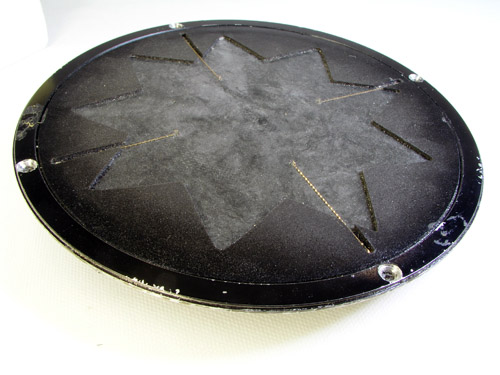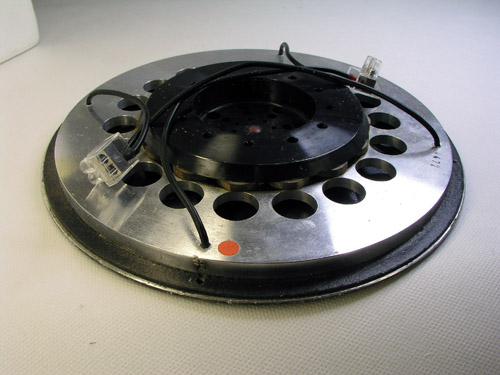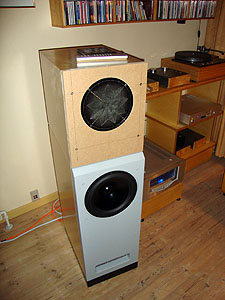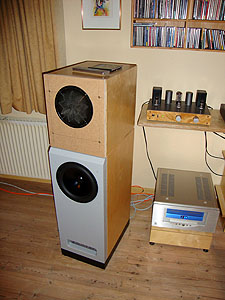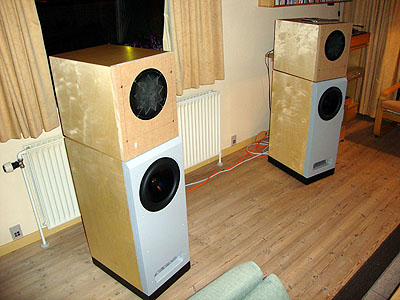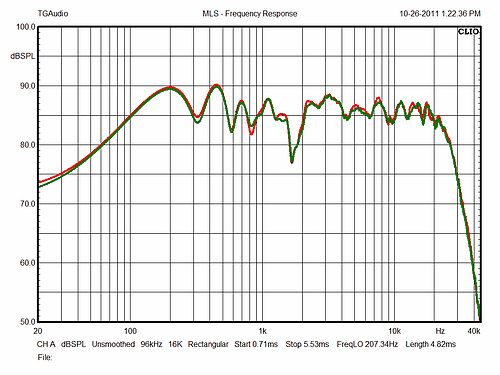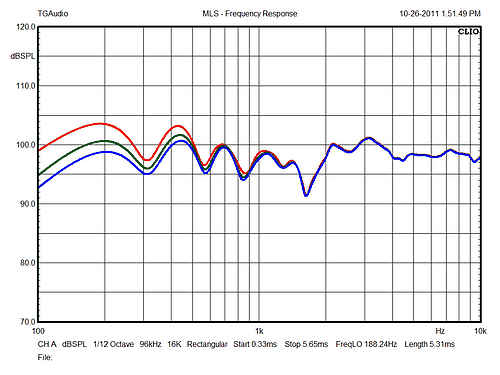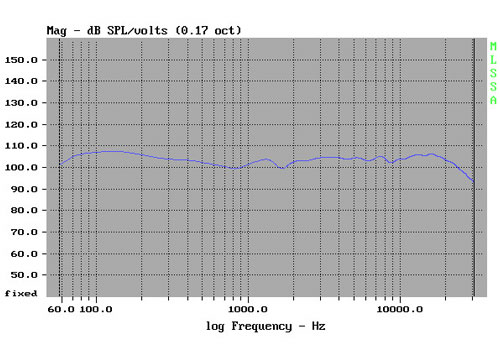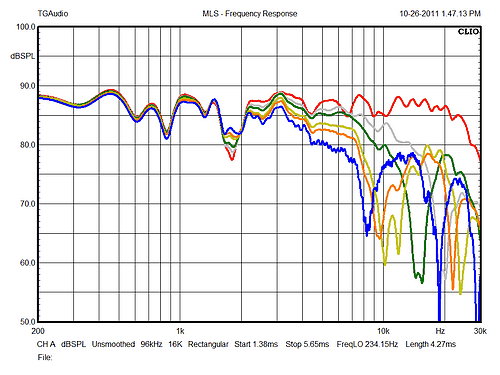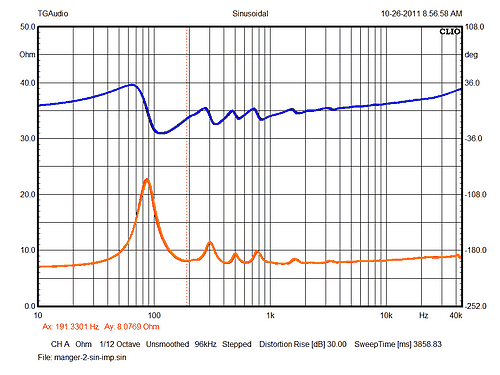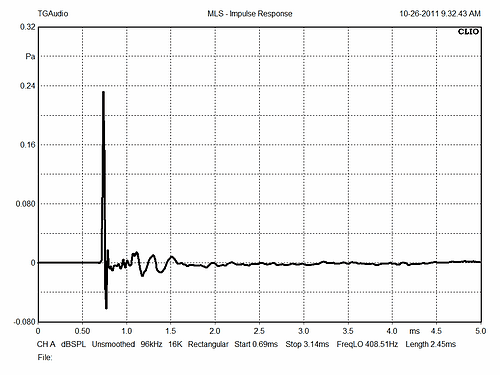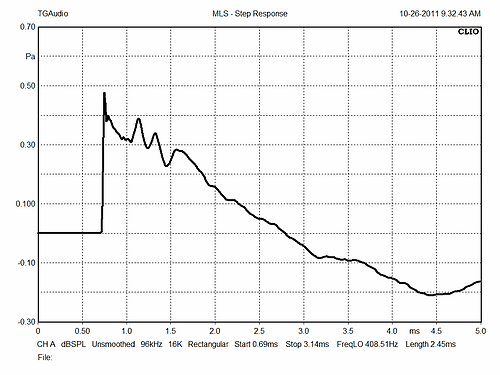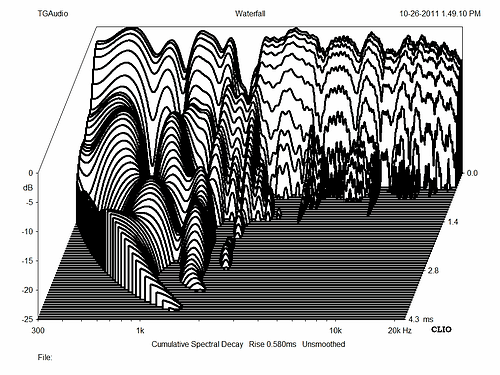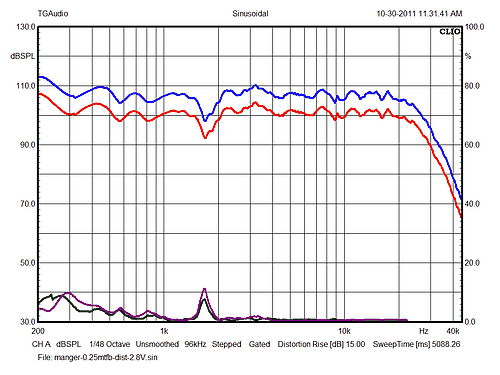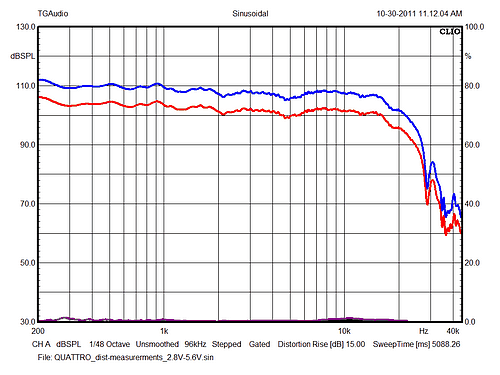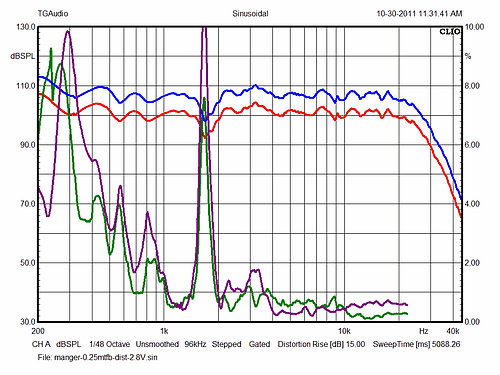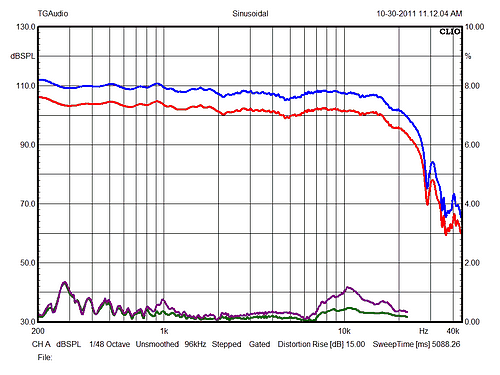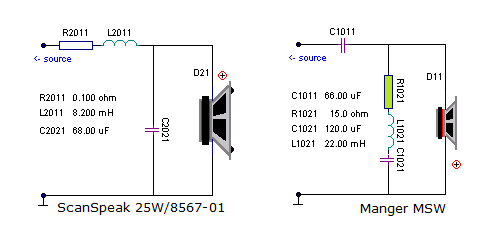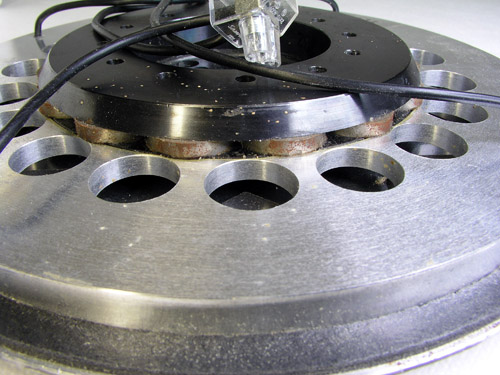|
Manger
MSW Transducer
Copyright
2011 © Troels Gravesen
THE
MANGER TRANSDUCER
MEASUREMENTS
CABINET
CROSSOVER
STORAGE
(!)

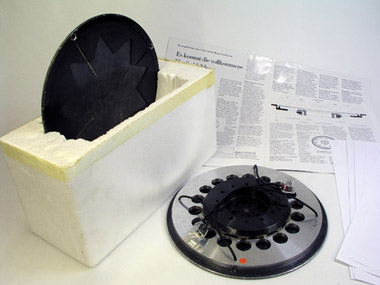
Left: Manger Zerobox
from Manger website. Right: The MSW drivers as delivered from Manger
for diy.
Link
to Manger website
My website may be an exercise in
well-trodden paths into loudspeaker building. At least one reader
thought so and as I couldn't promise him projects on electrostatic or planar
speakers, he offered me a pair of Manger MSW transducers for loan. In return I would document my findings, hence this article.
These MSW drivers are one of a kind
and the result of years of development by Josef W. Manger in Germany.
To learn about the ideas and principles behind these drivers, I suggest visiting
the German Manger website: www.manger-msw.de
I've been well aware of these drivers
for decades but never had the chance of hearing what they could do. In
principle this driver should be the ideal solution to having an
extended range unit covering all of the midrange and treble. Xmax is
limited (3.5 mm), thus requires a high-pass filter and a bass driver
to handle lower octaves up to e.g. 200 Hz. The suggested high-pass
filter should be 1st order and recommended are 60-100 uF for the 8
ohms version. Due to the high impedance of the driver I found 66 uF
(high quality Jantzen Superior Z-cap) suitable for mating ScanSpeak 25W/8567-01 alu bass driver. In fact, this bass driver does
really well in my Jenzen
TL design and might pop up in some future Jenzen design.
As all of the sound emanates from the
same flat diaphragm, this should present a sound stage free of any
phase distortion in all of the midrange and treble range. No (passive)
crossover in the troublesome upper-mid/lower treble range. How about
that?
As can be seen from measurements below we have an overall balanced
presentation and as Richard Vandersteen points out: The human ear is less
sensitive to linear distortion when we do not have sudden phase shifts,
thus we can have e.g. +/- 3 dB variation in amplitude
without noticing too much.
What struck me the most is the extremely linear response from 10-25
kHz. Flat! Remarkably indeed. Getting a 3 inch voice coil to perform
this way is quite an achievement. What to look for in frequency
response graphs are peaks superseding dips as these most often
indicate serious phase changes. No such thing could be found in the
performance of the
Manger drivers although there are some problems around 1.5 kHz (- the
mechanical crossover....)
My expectations were high, really
high, so what did I hear?
Well, not only is the MSW transducer one of a kind technically, also
so sonically. This driver really does deliver a balanced presentation,
very much to my liking and regardless of musical genre, I couldn't
point out any particular preference for any kind of music, being
classical, jazz, pop or rock. The presentation is speedy and dynamic
and despite extremely limited dispersion in the 10-20 kHz range I
didn't find them particularly difficult in setting up and toeing in.
Moving one seat in the sofa immediately reduce airiness due to
the lack of dispersion in upper octaves, but still, a credible
soundstage was apparent from a wide dispersion in
upper-mid/lower-treble.
Now to the troublesome parts: The MSW driver doesn't handle
significant sound levels well. Soon the sound becomes congested and
details are smeared - and I'm not talking really loud, only loud, e.g.
peak 95 dB @ 1 meter.
Despite the lack of crossover in the troublesome upper-mid/lower
treble range it did not handle Siri's
Killer Note well. This was very disappointing. I had great hopes
for this. At the same time I was doing a new crossover for an old Dali
310 speaker (Vifa P17 + OEM tweeter) and even with modest quality
components, this speaker handles this trouble note better!
Next, my expectations regarding sound stage depth were sky high and I
was seriously disappointed. These drivers have peculiar presence
quality that is not due to any elevated frequency band as such, but nevertheless something that makes this driver one of a kind.
I'm intrigued by this as I can't find any possible explanation except
the diaphragm being flat compared to most other transducers. Again the
vintage Dali 310 did better in revealing the depth of the room in
which a recording had taken place. It's not that the Mangers lack
transparency as such, only the depth of the sound image seems quite
limited. Really strange - and in accordance with what my supplier of
the Manger units had noticed. I didn't know his views before I tried
the drivers, it has to be said, so I wasn't biased. Nor had
a read any of the numerous reviews available from Manger
website.
I tried other cabs for the Mangers and the results were the same, so
I'm sure this is not due to the Jenzen TL mid cab not being suitable
for these drivers.
These drivers are easy to install and
if you're not a head banger and if you're fed up with mating midrange
drivers and tweeters, give them a try. They're not particularly
demanding on baffle size and shape and finding a 86-87 dB bass driver
to handle lower octaves is easy too. Give the bass driver a 2nd order
filter and reverse polarity of the Mangers - and you're flying. By the
way: "Listening from another room" is good despite lack of treble. I would
like to hear what the Mangers can do
with two additional units placed on the sides of the mid cabinet as
can be seen from the bigger commercial versions, but buying six
Mangers is serious money. One driver is 700 £. Click here.
Many hours later:
Hmm.... Looking again at the
dispersion characteristics, I feel more and more certain this is where
to look for an explanation on the lack of perceived soundstage
depth.
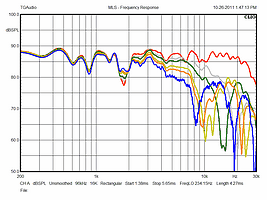
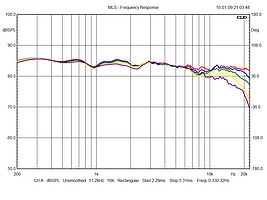
Left: Manger at 0-5-10-15-20-25o. Right: SP44
up to 40o off axis.
Very early we have a
significant reduction of treble dispersion compared to e.g. SP44,
which may be unusually good with regard to this, but nevertheless.
Listening to the Mangers at low level and a bit off-axis, the lack of
dispersion becomes more apparent and it's a bit like listening to a
"transistor" with a deeply recessed speaker like seen on ghettoblasters. The sound is closed in and we miss the highs that
are part of rendering room information.
Next: The Manger is like a gigantic ring-radiator and from the Manger
website we can see images of which parts of the membrane vibrate the
most at various frequences. Regardless of this, the Mangers will to
some extent suffer the same fate as large fullrange drivers; it
starts beaming as soon as the wavelength supersedes the diameter of
the cone. Beaming means smearing of detail and we loose sense of
depth. Every single time I've added a tweeter to a fullrange 8" driver at
3-4 kHz, the result is increased sense of depth and perspective. We
see fullrange aficionados stuffing their fullrange drivers with
gigantic mushrooms, light bulbs or whatever to overcome the intrinsic
problems of having a large cone doing it all. It's hard to fool
physics here and trying so is full of compromises.
After these experiences I took the Mangers to the workshop again to do
distortion measurements as can be viewed below. I should have done
this in the first place. The drivers at hand have been reconed at the
factory and used very little since then and considering the
consistency in frequency response and impedance I believe these
drivers are working properly. Nevertheless they display significant
levels of distortion.
CONCLUSION
These Manger drivers do
not get my full-hearted recommendation. Price is fairly high,
soundstage depth is limited, power handling is limited and distortion
soon a problem.
The
inability to present a transparent soundstage with good depth is what
I rate the most serious shortcoming here. Three drivers as seen from
the larger commercial variants may solve power handling problem and well, we
may easily pay 6 x 700 £ for good commercial speakers, so I don't
consider them overpriced as such. Making a Manger driver probably
takes hours and even from these old units, pair matching is nothing
short of excellent.
At the end of the day my AT-SW
speakers will for the same price (two MSW units) beat the crap out of
the Mangers. You may find this inappropriate self-praise, but I'll
stick my neck out.
Post scriptum:
After finishing the article I started a google search on "Manger
MSW distortion" and found this article
on the Manger Zerobox 109. I was kind of relieved to find an article
very much confirming my measurements and to some extent my evaluation.
In particular with regard to distortion. Quote: "However, this
transient accuracy is achieved at the expense of frequency response
and nonlinear distortion, both of which lie outside the specifications
of most monitor loudspeakers".
|





